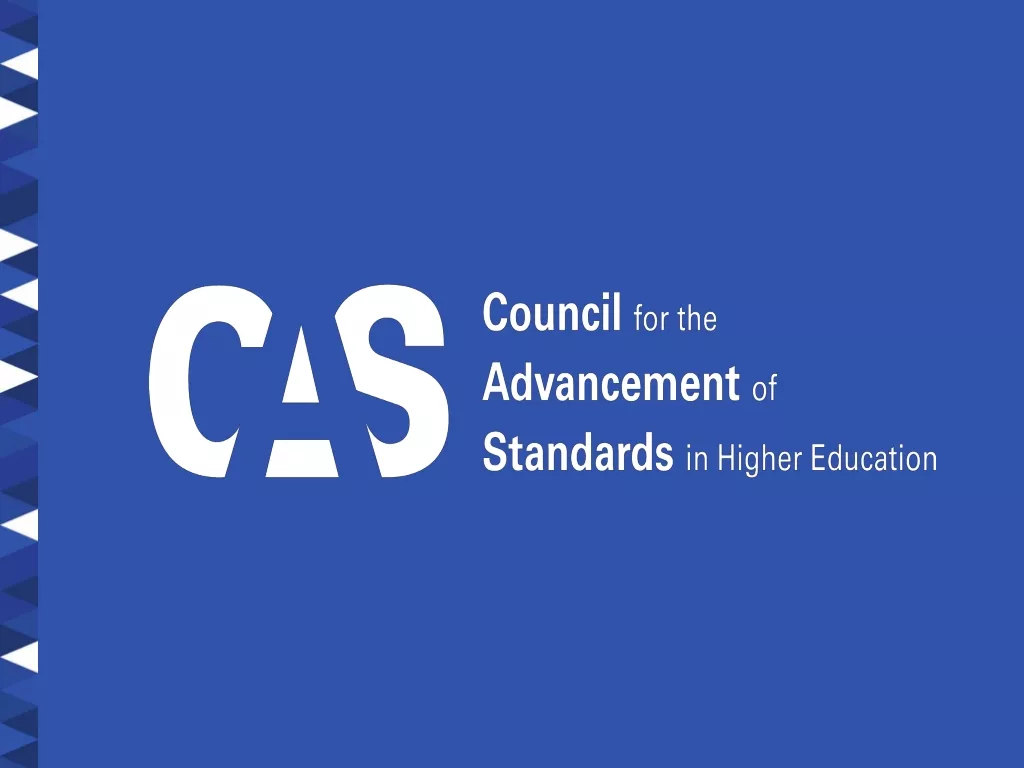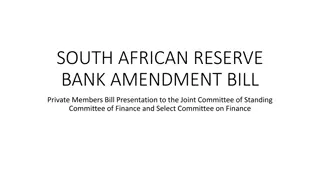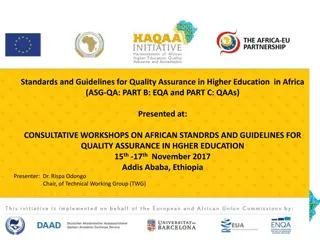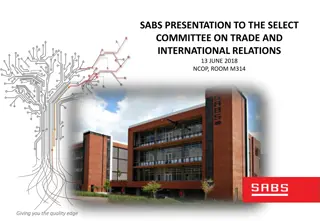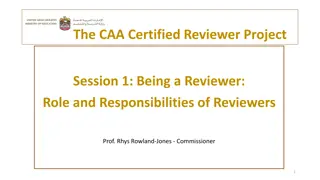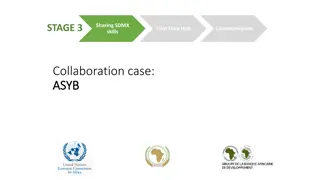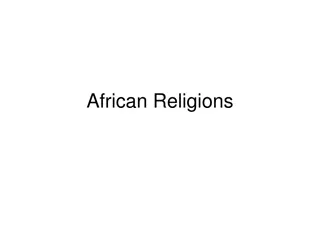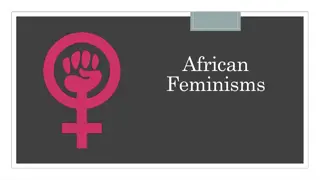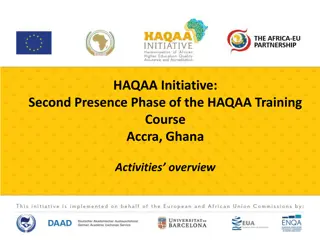African Standards and Guidelines for Higher Education in ASG-QA Training Presentation
Development and introduction of African Standards and Guidelines for Quality Assurance (ASG-QA) presented at the HAQAA Initiative Training highlighted the purpose, drafting process, principles, and methodologies. Membership of the Technical Working Group (TWG) involved experts from Africa and Europe, focusing on internal and external quality assurance in higher education institutions to enhance practices and transparency while promoting trust and quality improvement.
Download Presentation

Please find below an Image/Link to download the presentation.
The content on the website is provided AS IS for your information and personal use only. It may not be sold, licensed, or shared on other websites without obtaining consent from the author. Download presentation by click this link. If you encounter any issues during the download, it is possible that the publisher has removed the file from their server.
E N D
Presentation Transcript
African Standards and Guidelines for Higher Education in ASG-QA Presented At The HAQAA Initiative Training By Dr. Rispa A. Odongo Chair TWG, HAQAA Initiative 31stMay to 2ndJune 2017, Accra, Ghana
OUTLINE OF PRESENTATION 1. Introduction 2. What Are the ASG-QA 3. The Purpose of ASG-QA 4. The Drafting Process 5. Principles and Methodologies 6. The Contents of ASG-QA
1. INTRODUCTION Development of African Standards and Guidelines for Quality Assurance (ASQ-QA) is one of the critical activities HAQAA 1.1 The Technical Working Group (TWG) is responsible for: Drafting the African Standards and Guidelines (ASG-QA) for quality assurance (Focus of this presentation). Terms of Reference of HAQAA TWG The development of an illustrative model for external review of QAAs in Africa, to identify compliance with ASG-QA.
1.2 Membership of TWG The members of the Working Group consist of eight experts seven from Africa and one from Europe with added special language expertise. Africa 1. Prof. Abdle Karim Koumare Afriain de Formation en Pedagogie (French) 2. Prof. Eid Youhansen President, NAQAAE, Egypt (English & Arabic), 3. Prof. Jeffy Mukora Execitive Director, CNAQ Mozambique (English & Portuguese) 4. Mr. Mock Shivute Executive Director, NCHE, Namibia (English) 5. Ms. Anneley Williamsen QA Director, University of Namibia (English) 6. Dr. Rispa A. Odongo QA Expert - Former Senior Staff of CUE, Kenya (Chair, English) European Union (EU) 1. Ms Caty Duykaerts Director, AEQES (English & French) 2. Ms Paula Ranne ENQA Rep, Deputy Director ENQA (Coordinator, ENglish) Advisory Board of HAAQA Initiative (Violet )- Provides regular advise and support
2. WHAT ARE ASG-QA? ASG-QA: Are a set of standards and guidelines for internal and external quality assurance in HE in Africa. They are not prescriptive. They provide a road map for quality attainment in HEIs and QAAs. The standards are stated as common minimum standards or requirements. The guidelines are stated in more specific terms to allow for gathering of evidence in support of the status of quality at HEIs and QAAS. HEIs or QAAs can add more standards to reflect their own traditions or contexts. The ASG are generally based on common principles , they build on existing national, regional and continental bodies QA bodies. They are broad enough to allow for diversity, yet safeguarding comparability.
3. PURPOSE OF ASG-QA The ASG-QA will support higher education institutions and quality assurance agencies in Africa in implementing good practices for quality assurance; and specifically to: a) Have a common framework and understanding of QA among stakeholders at continental, regional, and national levels. b) Develop mutual trust - facilitate recognition and mobility of students and human resources. c) Ensure quality improvement/enhancement through self-assessment, external review and continuous M & E. d) Promote transparency and accountability by providing appropriate information to the public. e) Promote sustainable quality culture in HEIs. f) Promote international competitiveness of Africa s HE system.
4. ASG-QA DRAFTING PROCESS 4.1 a) Production of Working Document Documents All members of the TWG provided lists of available QA documents from their countries and /or or regions. Mapping Matrix was developed for existing Standards and Guidelines in Quality Assurance of African Countries (IQA - very high level of similarities in standards) Using the Matrix, Chair produced Working Document incorporating the standards as practiced by various QAAs and regional QA bodies was produced. The Working Document was interrogated by all members for improvement of document. The Working Document was discussed by TWG members and presented to the HAQQA Advisory Board for advise at meeting in Accra, Ghana in January 2017 Zero Draft. Further discussion Cairo - Draft 1. b) c) d) e) f) Mapping revealed high level of similarities in the IQA standards used by different countries, (See below)
4.2. Mapping Matrix: Internal quality assurance in Africa (IQA) Internal QA standards ANQAHE Egypt IUCEA Kenya Ethiopia Malawi Mozambiq ue Lesotho SADC Namibia Mauritius Zimbabwe CAMES Senegal Vision, mission, objectives, strategic planning Governance, administration, leadership, constituency, autonomy (including financial and logistical dimension) Study programmes* Research Quality assurance (institutional self-evaluation), including of study programmes separately Facilities, physical resources, infrastructure (mostly ICT) Staff** Students, alumni, student support services, students with special needs Learning and teaching Financial resources Community engagement, industrial partnerships Academic integrity, ethics, social responsibility Management of information and communication Modes of delivery Internationalisation Post-graduate studies
4.3. Mapping Matrix: External Quality Assurance (EQA) IUCEA Ethiopia Malawi SADC Namibia Guidelines and processes; mission and objectives for external QA Documentation, reporting, dissemination of information Monitoring and evaluation, follow-up procedures System-wide analyses, coherence of external QA with national policies Peer-reviewing Periodic reviews Capacity and resources available for the external QA Processes fit-for-purpose Use of internal QA procedures Accountability Academic freedom and autonomy Independence The primary responsibility within the institution Conduct, confidentiality Equality of public and private HEIs
4.4. Mapping of Internal Quality Assurance of QA Agencies a) Only in very few countries. Areas covered: 1. Mission statement and governance 2. Independence of EQAA 3. Legal status of EQAA (official status) 4. Periodic programme and institutional review 5. External quality assurance criteria and processes used by agencies (use of external quality assurance procedures for higher education) 6. Activities for quality assurance 7. Resources 8. External review of EQAA 9. Accountability (internal quality assurance and professional conduct) 10. Benchmarking, networking and collaboration
4.5. Mapping Matrix: ODL Rwanda Kenya SADC 1. Approval and periodic review of programmes 2. Needs assessment 3. Vision and mission 4. Objectives and strategies 5. Governance and administration 6. Regional centres 7. Study centres 8. Collaborative arrangements 9. Mode of delivery 10. Preparation of course materials 11. Curriculum development 12. Instruction level and staff 13. Self-learning materials P14. e-testing or piloting learning materials 15. Review of curriculum and learning materials 16. Orientation and training on development of learning materials 17. Orientation to course tutors 18. Orientation to non-academic staff 19. Student services 20. Residential sessions 21. Admission into the programmes 22. Duration and structures of academic programmes 23. Examination regulations 24. Assessment procedure 25. Student evaluation 26. Course evaluation 27. Evaluation of learners support services 28. Evaluation of staff 29. Advertising, communication
4.6 Development of Working Document From the mapping resulted into the following proposed Standards: Part A: Internal Quality Assurance (IQA) - 19 Part B: External Quality Assurance (EQA) 11 Part C: Quality Assurance Agencies (QAAs) 10 Part D: Open and Distance Learning (ODL) - 16 These were discussed in Accra, Ghana in January 2017 by TWG and HAQAA Advisory Board.
Comments Raised by TWG and Advisory Board. a) The Standards were too many and should be merged where appropriate. b) Reconsider Open and Distance Learning, whether to merge with IQA or not. c) Consider possibility of merging EQA and QAAs d) Agreed on numbering Format - Part A, Part B, Part C , Part D. e) The standards and guidelines should be stated in flexible terms to allow countries to develop their unique standards and guidelines (ESG). Through further discussion online, a Zero Draft was developed and discussed in Cairo, Egypt in April, 2017
4.7 Zero Draft ASG-QA Accra discussions resulted into: 1. Internal Quality Assurance (IQA) - 14 (ODL incorporated here) 2. External Quality Assurance (EQA) 7 3. Quality Assurance Agencies (QAAs) 8 4.8 Further discussion in Cairo Discussions resulted into: 1. Internal Quality Assurance (IQA) - 13 (ODL incorporated here) 2. External Quality Assurance (EQA) 7 3. Quality Assurance Agencies (QAAs) 8 Draft 1 ASG-QA See Tables below for details !!!
Working Document - Part A: IQA Zero Document Part A: IQA Draft 1 Part A: IQA 1. Vision, Mission, and Goals Objectives 1. Vision, Mission, and Strategic Objectives 1. Vision, Mission, and Strategic Objectives 2. Planning and Strategic Development (Policy Plan) 2. Governance and Administration 2. Governance and Administration 3. Governance and Administration 3. Human Resources 3. Human Resources 4. Human Resources (Academic Staff / Teaching Staff) 4. Pre-testing or Piloting of Learning Materials 4. Design, Approval and Monitoring of Programmes 5. Design and Approval of Academic Programmes 5. Design and Approval of Programmes 5. Teaching, Active Learning and Assessment 6. Teaching and Learning 6. Teaching, Active Learning and Assessment 6. Infrastructure and Facilities 7. Facilities and Infrastructure 7. Infrastructure Facilities and Students Support Services 7. Student Recruitment, Admission, Support Services and Certification 8. Linkage with Industry 8.. Student recruitment, admission, progression and certification 8. Research and Innovation 9. Student Recruitment and Admission 9. Postgraduate Studies, Research and Innovation 9. Community Engagement 10. Student Support Service 10. Community Engagement 10. Information Management 11. Student Assessment 11. Information Management 11. Public Communication 12. Management of Postgraduate Studies 12. Advertising and Public Communication 12. Cooperation, Staff and Student Mobility 13. Research and Innovation 13. Cooperation, Staff and Student Mobility 13. Financial Resource Management 14. Community Engagement 14. Financial Resource Management 15. Information Management (ODL merged with IQA!!!) 16. Collaboration (Internationalization) 17. Institutional Quality Assurance Management
Working Document - Part B: EQA Zero Document Part B: EQA Draft 1 Part B: EQA 1. Principles of EQA 1. Objectives of EQA and Consideration for IQA 1. Objectives of EQA and Consideration for IQA 2. Mission (EQA Policy) 2. Designing Mechanisms Fit-For- Purpose 2. Designing Mechanisms Fit- For-Purpose 3. Objectives of EQA 3. Implementation Processes of EQ 3. Implementation Processes of EQ 4. Designing Methodologies fit-for-purpose (Standards and Guidelines and Processes foe EQA) 4. Independence of Evaluation 4. Independence of Evaluation 5. Implementation Processes (Consideration of IQA) 5. Decision and Reporting of EQA Outcomes 5. Decision and Reporting of EQA Outcomes 6. Independence of Evaluation (Use of Peer Review Experts) 6. Periodic Review of Institutions and Programmes 6. Periodic Review of Institutions and Programmes 7. Decisions of EQA Activities (Outcomes) 7. Complaints and Appeals 7. Complaints and Appeals 8. Reporting of EQA Activities (Disclosure) 9. Periodic Review of Institutions and Programmes 10. Complaints and Appeals 11. Coherence of National and Regional Policies and Practices
Working Document - Part C: QAA Zero Document Part BC QAA Draft 1 Part BC QAA 1. Legal Status of QAA (Official Status) 1. Policies, Processes and Activities of Quality Assurance Agency 1. Policies, Processes and Activities of Quality Assurance Agency 2. Mission Statement and Governance 2. Legal Status 2. Legal Status 3. Resources 3. Vision and Mission Statement 3. Vision and Mission Statement 4. Independence of QAA 4. Financial and Human Resources 4. Financial and Human Resources 5. External Quality Assurance Criteria and Processes used by QAA (Thematic Analysis) 5. Independence of QAA 5. Independence of QAA 6. Activities for Quality Assurance 6. Internal Quality Assurance Criteria and Processes Used by QAA 6. Internal Quality Assurance Criteria and Processes Used by QAA 7. Periodic and Institutional and Programme Review 7. Benchmarking, Networking and Collaboration 7. Benchmarking, Networking and Collaboration 8. Accountability (Internal Quality Assurance and Professional Conduct) 8. Periodic Review of QAAs 8. Periodic Review of QAAs 9. External Review of QAA 10. Benchmarking, Networking and Collaboration
Working Document - Part D: ODL 1. Vision, and Mission, Strategic Planning and Governance 2. Student Admission and Access 3. Design, Approval of Academic Programmes 4. Mode of Delivery 5. Learning Materials 6. Pre-testing or Piloting of Learning Materials 7. Instructional Level Staff 8. Staff Orientation and Training 9. Student Support and Services 10. Residential Sessions 11. Examination Regulations 12. Student Assessment Procedure 13. Evaluation of Staff and Students Support Services 14. Periodic Review of Programmes (Review of Curriculum and Learning Materials) 15. Advertising and Communication (Accountability and Public Information) 16. Quality Assurance of ODL
5. PRINCIPLES AND METHODOLOGIES 5.1 Principles Quality and QA are primarily the responsibility of HEIs The autonomy, identity and integrity of HEIs are acknowledged and respected. HEIs and QAAS can adapt the standards and guidelines to their higher education system and context. 5.2 Methodologies Standards have or will be been subjected to consultation with stakeholders (Draft Questionnaire being developed). Standards have been benchmarked with international standards Their use is made of by external peer reviewers with diverse expertise and experience.
6. THE ASG-QA 6.1 Application ASG-QA apply to all types of HEIs in Africa irrespective of mode of delivery and QAAs. ASG-QA should be applied taking into account existing qualification frameworks (QF) and credit transfer and accumulation system (CATS). 6.2 Part A: Focuses on internal quality assurance (IQA) of HEIs; ODL is incorporated into this part, IQA Part B: Describes the methodologies (or standards) used for external quality assurance. Part C: Focuses on internal quality assurance of quality assurance agencies. Presentation of ASG-QA 3 Parts N.B: The 3 parts are interlinked and together form the basis for an African Quality Assurance Framework (See Fig. 1).
Fig. 1: Inter-linkage of four parts of ASG-QA Internal Used by HEIs: - to assure their own quality - when doing self-assessment/evaluation in preparation of EQ) by a recognised QAA PART A IQA External Used by QAAs: - when conducting institutional audits /accreditation or programmeaccreditation at HEIs Internal Used by QAAs for internal quality assurance: - to assure the quality of their own activities - when doing self-assessment/ evaluation in preparation for EQA by peers/recognised QAAs ASG-QA PART B PART C EQA QAAs
Part A: Standards and Guidelines for Internal Quality Assurance (IQA) of Higher Education Institutions Part A presents standards and guidelines for internal quality assurance (IQA) at the level of higher education institutions. The IQA standards and guidelines have incorporated delivery by open and distance learning (ODL) modes. The standards and guidelines cover areas that are considered essential for attainment of provision of quality higher education.
Areas Covered under Part A: IQA The standards and guidelines in Part A address the following 13 areas: 1. Vision, Mission, and Strategic Objectives 2. Governance and Administration 3. Human Resources 4. Design, Approval and Monitoring of Programmes 5. Teaching, Active Learning and Assessment 6. Infrastructure and Facilities 7. Student Recruitment, Admission, Support Services and Certification 8. Research and Innovation 9. Community Engagement 10. Information Management 11. Public Communication 12. Cooperation, Staff and Student Mobility 13. Financial Resource Management Some examples are provided as examples:
1. Vision, Mission, and Strategic Objectives Standard The institution shall have published vision and mission statements, strategic objectives; and clear policies and procedures that are consistent with the vision and mission statement, which reflect the institution s commitment to continuous quality enhancement. Guidelines The vision, mission and strategic objectives are: publically disclosed; reflect the aspirations and needs of stakeholders; Show strategic development plans and targets. The institutional vision and mission on quality assurance are translated into clear policies and strategic plans, which are operationalised into achievable goals.
The institution ensures that there is a robust and well-functioning institutional quality assurance system for all its academic and research activities. The institution therefore ensures that: a) Various forms of planning - strategic plans , institutional, academic, financial), well re coordinated for quality of academic outcomes; b) Institutional medium-term and long-term plans reflect the programmes being offered; c) The research focus ensure continuous improvement; d) Collegiate formulation of the plans - plans known to stakeholders; e) Plans promote institutional integrity , responsiveness to change; f) The IQA system - formally established - adequate resources; and g) There is continuous , periodic monitoring, evaluation , benchmarking of processes.
2. Governance and Administration Standard The institution shall have clearly articulated governance and management structures, which ensure sound and ethical governance and management practices, and supports the achievement of its mission and legal mandate. Guidelines The institution: a) Has qualified, competent and experienced leadership b) Has relevant organs of governance - For example, University Council, Senate, Management Board, Student Body; Various Committees which are properly coordinated to ensure efficiency. c) Has policies and procedures for delegation of authority; d) Has clear communication systems and networks for promotion of internal, external information circulation and public accountability; e) Makes use of its autonomy responsibly;
Guidelines Continued f) g) Enables students participation in decision-making; Ensures regular consultations with stakeholders, reporting and follow up actions to promote cohesion, harmony with the institution; Emphasizes ethics, transparency and academic integrity; Promotes institutional integrity and responsiveness by advocating and demonstrating honesty and non-discrimination in its treatment of staff, students, members of the public; Publishes on a regular information about courses offered, research undertaken and community services provided; Has processes for dealing with academic misconduct by students or staff; Has policies and procedures for managing conflicts of interest; and m) Has effective, systematic, timely and fair processes for handling of complaints, grievances and appeals. h) i) j) k) l)
Guidelines Continued The institution enables female and male faculty and office holders to realise equal outcomes in their academic and professional performance. More specifically, there is: a) Ensure gender balanced in staff composition, across campuses, and degree programmes. b) Gender balance in management and decision-making c) Inclusive management and leadership.
10. Information Management Standard The institution shall ensure that it collects, analyses, and makes use of relevant information for effective management of their programmes of study and other activities of the institution. Guidelines Reliable data is crucial for informed decision making and for understanding what is working and what needs to be addressed. Effective processes for collecting and analysing information on academic programmes and other activities of the university feed into the internal quality assurance system. The information gathered will depend on the vision and mission of the institution. However, the following are important to address: a) Key performance indicators; b) Profile of student population (including gender); c) Learning resources and available student services; d) Student progression, and drop-out rates, and graduation rates; e) Students satisfaction with programmes; and f) Career paths for students. g) It is important that both students and staff are involved in analysis and follow-up activities to address the shortcomings.
Part B: Standards and Guidelines for External Quality Assurance For purposes of accountability and quality enhancement HEIs should subject themselves to periodic external assessment. Part B of the ASG-QA describes the methodologies (or standards) used for external quality assurance (EQA) of higher education institutions. Part B: Takes into account the standards and guidelines in Part A (IQA) for higher education institutions, Ensures that IQA examined is relevant to and is efficient for the concerned higher education institution, Ensures that there is consistency between internal quality assurance by institutions themselves and external quality assurance.
Areas Covered under Part B: EQA The standards and guidelines in Part B address following 7 areas: 1. Objectives of EQA and Consideration for IQA 2. Designing Mechanisms Fit-For- Purpose 3. Implementation Processes of EQ 4. Independence of Evaluation 5. Decision and Reporting of EQA Outcomes 6. Periodic Review of Institutions and Programmes 7. Complaints and Appeals Some examples are given:
1 Objectives of EQA and Consideration for IQA Standard EQA should ensure that the higher education institution has clearly articulated vision and mission statements, and it should help the HE institution ensure the effectiveness of its internal quality assurance mechanisms, providing an additional instrument for assessing institutional quality. Guidelines EQA is based on institution s responsibility for the quality of its academic programmes and other provisions, and therefore it is important that external quality assurance recognises and supports the institution s responsibility for its quality assurance. EQA therefore assists higher institution to:
Guidelines Continued.. a) b) Appreciate the link between IQA and EQA; Adhere to established quality assurance principles, standards and guidelines in the higher education sector. Develop and entrench institutional quality culture by establishing mechanisms for continuous quality improvement / enhancement; Provide a basis to benchmark inputs, processes, outputs with other higher education institutions nationally, regionally and internationally; Determine the institution s capacity to offer academic programmes; Assess institutional compliance with legal and other requirements; and Provide independent evidentiary information to its stakeholders, the general public and international community that it is offering quality higher education. Be recognized and accepted nationally, regionally, and internationally. c) d) e) f) g) h)
4. Independence of Evaluation Standard EQA shall be carried out by Panels of external experts / peer reviewers drawn from a wide range of expertise and experience. Guidelines The principle of best practices of EQA is based on the consistent use of a wide range of expertise and experiences: a) Peer reviewers are drawn from academics, students, employers or professional practitioners; b) To ensure professionalism, consistency and transparency of output of experts / peer reviewers, it is necessary that they - Are carefully selected, Have appropriate skills and are competencies to perform tasks assigned to them, Adequately inducted on EQA principles and procedures before undertaking external review, Are independent and have no-conflict-of-interest in the institution or programme and sign Declaration of Independence Form ,
c) In the case of possible conflict of interest, the institution is given the opportunity to object members of the proposed Review Panel; and Involvement of international experts is considered as good practice in EQA. d)
7. Complaints and Appeals Standard Processes of lodging complaints and appeals should be clearly defined and communicated to the institutions concerned. Guidelines In order to safeguard the rights of the institutions and to ensure fairness in the decision making process, it is important that institutions have access to the processes that allow them to raise issues of concern with the agencies if they can demonstrate that the outcome of their external review is not based on sound evidence. It is therefore critical that: a) There is established an Appeals System / Committee / Board b) Institutions are allowed to raise issues of concern consistent with the appeals system. c) There are clearly defined complaints and appeals processes and procedures which are consistently applied. d) Appeals are handled professionally and consistently applied, and feedback provided.
Part C: Internal Quality Assurance for Quality Assurance Agencies Part C of the ASG-QA is for the purposes of internal quality assurance of Quality Assurance Agencies through self-assessment/evaluation of its policies, practices, procedures and activities and/or for external assessment/evaluation by another body/peer organisation.
The standards and guidelines in Part C cover the following 8 areas : 1. 2. 3. 4. 5. 6. 7. 8. Policies, Processes and Activities of Quality Assurance Agency Legal Status Vision and Mission Statement Financial and Human Resources Independence of QAA Internal Quality Assurance Criteria and Processes Used by Benchmarking, Networking and Collaboration Periodic Review of QAAs
2. Legal Status Standard The QAA shall be legally established as an autonomous body and recognised by competent public authority as the quality assurance agency at national/regional level. Guidelines When external quality assurance is carried out for regulatory purposes, institutions have the security that the outcomes of the process are accepted within the higher education system, the stakeholders, and the public.
5. Independence of QAA Standard The QAA shall be independent and autonomous in its operations, outcomes, judgements and decisions. Guidelines The QAA make independent decisions and judgements that are not subject to change by third parties. Independence of an agency includes the following: Organisational independence - Official documentation, such as legislative acts or statutes and instruments of governance, that stipulate the independence of the agency s work from third parties (e.g. HEIs, governments, other stakeholders). Operational independence - the definitions and operations of the agency s procedures and methods, nomination and appointment of qualified external experts (including institutions chance to object to any peer reviewer). Independence of formal outcomes the final decision of quality assurance activity remains the responsibility of the QAA even if experts / peers are involved in the quality assurance activity. 40
7. Benchmarking, Networking and Collaboration Standard The QAA shall promote and participate in international initiatives, workshops and conferences on quality assurance to exchange and share experiences and best practices. Guidelines It is important that the QAA remains relevant in its activities, the QAA: Collaborates with all competent bodies for quality assurance and accreditation; Shares accurate, reliable and easily accessible information on criteria and standards for quality assurance activities; Contributes to the development of and/or updating of the appropriate regional and other international conventions (e.g. REQ) and serves as national or regional information centres as appropriate; Participates in bilateral or multilateral agreements for facilitating the recognition or determination of equivalences of each country s qualifications and Contributes to regional and international efforts to improve the accessibility at the international level.
8. Periodic Review of QAAs Standard The QAA shall undergo periodic internal and external review in order to demonstrate its compliance with ASG-QA. Guidelines The QAA has a system for continuous quality assurance of its own practices and activities that emphasise flexibility in response to the changing nature of higher education, effectiveness of its operations, and its contribution towards the achievement of its objectives. The QAA, therefore: a) Conducts a comprehensive internal self-assessment of its practices and activities periodically, including data analysis, b) Subjects itself to periodic external review on the basis of the self-assessment; and c) Ensures that required recommendations are disclosed and implemented for improvement.
Summary - Some Comparisons Standards & Guidelines Draft ASG-QA European - ESG IQA 13 10 EQA 7 7 QAAs 8 7
9. Expectation of TWG from the Meeting What are your personal reactions to the ASG-QA? Value addition to your country s existing QA system /How will they be received in your country? How should they be communicated in your country? Any potential resistance? Your reaction on merging IQA with ODL?
GROUP WORK ON ASG-QA Group ASG-QA Part Moderators Group 1 French Speaking Countries Part A and Part B Adbou Larate Group 2 Goran (Jeffy - To support group by responding to questions) English Speaking Countries Part A and Part B Group 3 Felix (Rispa To support group by responding to questions) English Speaking Countries Part C
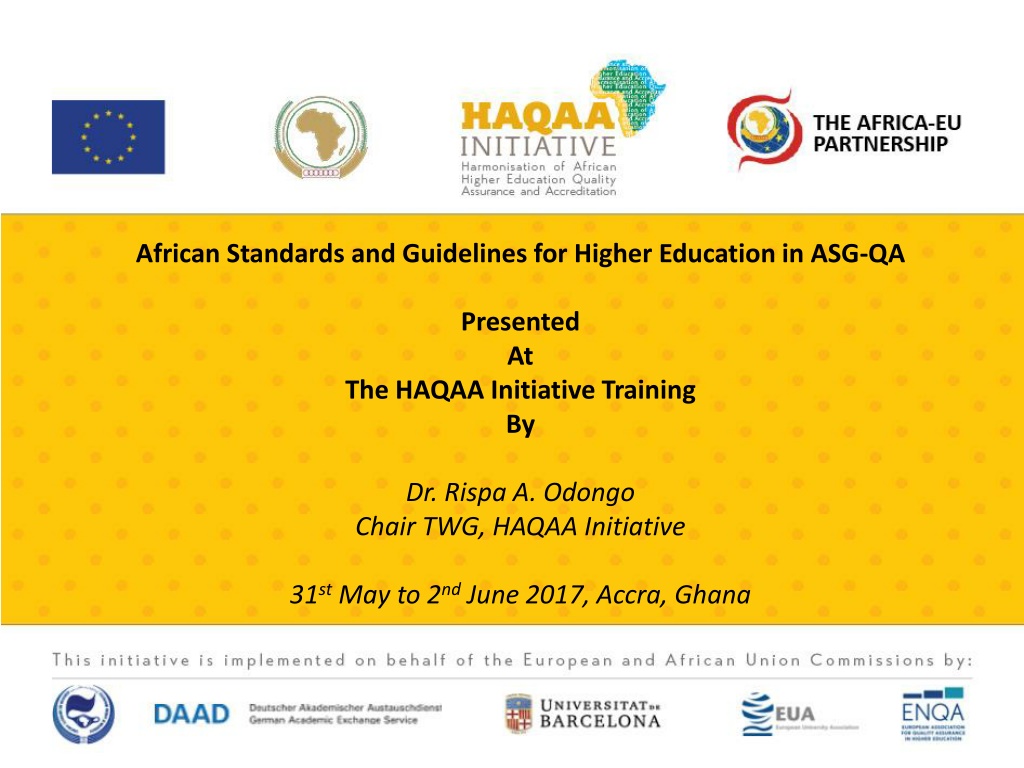
 undefined
undefined





 undefined
undefined undefined
undefined
